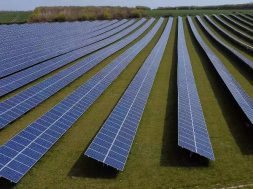
U.S. needs incentives to attract foreign solar firms – China’s Longi
BEIJING – The United States will need to offer incentives to attract foreign solar firms to invest there after U.S. President Donald Trump slapped steep tariffs on solar panel imports, an executive at Longi Green Energy Tech said on Tuesday.
However, Longi, one of China’s top solar cell makers, won’t give up on the U.S. market as a result of the move, global marketing director Xia Aimin said at a briefing.
China is the world’s biggest solar panel producer.
Xia said Longi still needs to assess the impact of Trump’s new policy, which was announced last month to help U.S. manufacturers, but which has alarmed Asian trading partners that produce lower cost goods.
The administration also put a tariff on imported washing machines.
“We realise that trade protectionism is going to have a severe effect on the solar market,” Longi’s chief strategy officer Shang Yaohua said at the same briefing.
“However, no matter how trade policy is heading, we will continue to expand capacity overseas and increase investment overseas,” he added.
The briefing came after Longi announced late on Monday that it would invest $309 million to double to 2 gigawatts (GW) the total capacity of a cell factory and module plant in India that are currently being built. They are scheduled to launch in the next couple of years.
India has overtaken Japan to become China’s biggest export market for solar products by sales value, accounting for more than 24 percent of China’s solar exports in the first 11 months of 2017.
But India last month proposed imposing a provisional safeguard duty at a rate of 70 percent on imports of solar cells from China and Malaysia in a bid to protect its domestic industry.
“The acceleration of capacity expansion overseas is to deal with recent import tariffs from the U.S. and India,” Xia said at the briefing, adding that Longi expects India’s solar market to grow rapidly.
Longi currently has 15 GW of silicon wafer capacity, 5.5 GW of solar cell capacity and 6.5 GW of solar module capacity at factories in China and Malaysia. It aims to expand its silicon wafer capacity to 45 GW by the end of 2020.
“We will cautiously assess our capacity expansion plan in overseas market, but will not rule out the possibility of setting up more factories in other countries,” said Shang.













